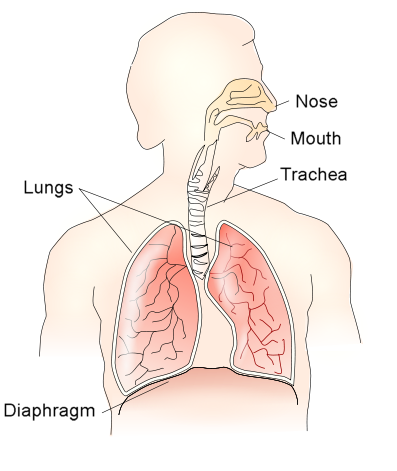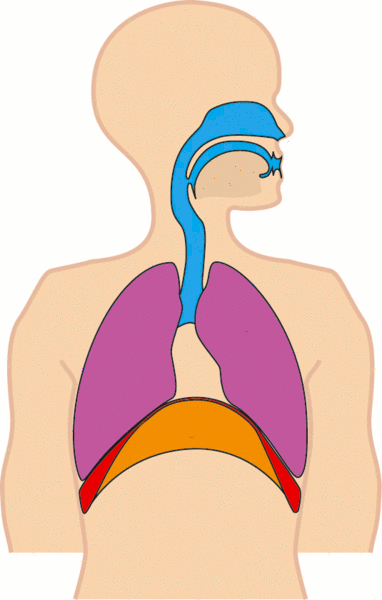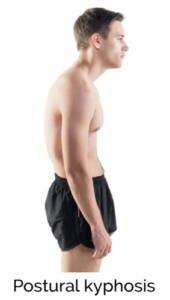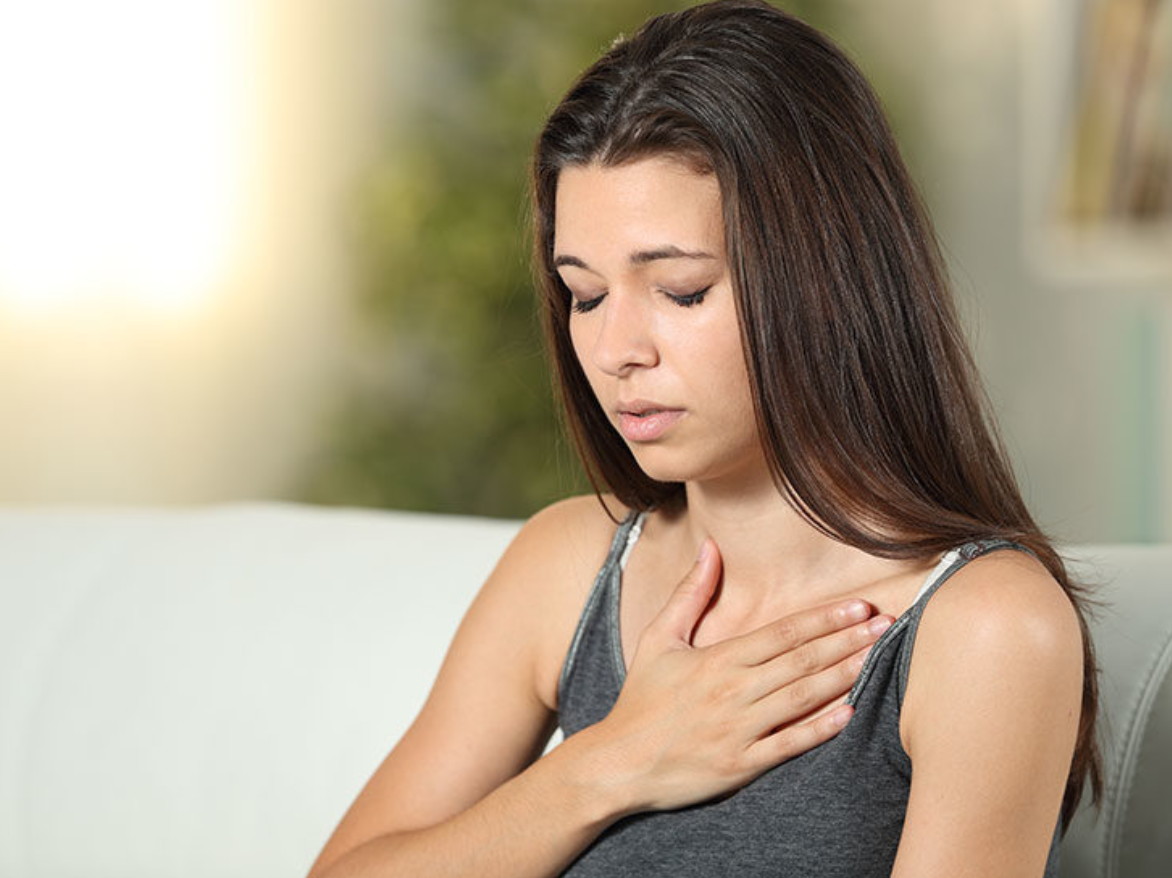Comment soulager la respiration superficielle
Le stress chronique, la posture et la tension musculaire peuvent tous jouer un rôle dans le développement d'une respiration superficielle, également appelée respiration thoracique. La respiration superficielle peut contribuer à des troubles médicaux graves tels que les troubles anxieux, les crises de panique, l'hyperventilation, l'état de choc, l'asthme, la pneumonie, l'œdème pulmonaire et l'accumulation de dioxyde de carbone dans le corps, connue sous le nom d'hypercapnie.
Pour la plupart d'entre nous, la façon dont nous respirons est habituelle, ce qui signifie que nous n'en sommes pas conscients. Il est facile de passer sa vie à respirer superficiellement, d'augmenter son niveau de stress et de s'exposer à des problèmes de santé, sans s'en rendre compte. Il est donc important d'être attentif à la façon dont vous respirez et de prendre le temps de vous entraîner à respirer de façon diaphragmatique.
Dans cet article, je discute :
- Types de respiration
- Pourquoi le stress chronique provoque une respiration superficielle
- Comment la posture et la tension musculaire provoquent une respiration superficielle
- Les muscles impliqués dans la respiration
- Les nerfs impliqués dans la respiration
- Respiration par le nez ou par la bouche
- Apprendre à respirer par le diaphragme
- Somatiques Cliniques exercices qui soulagent la respiration superficielle
Types de respiration : diaphragmatique, superficielle, claviculaire et eupnée
As you can see in the diagrams below, the diaphragm is an umbrella-shaped muscle located just below our lungs. In Respiration diaphragmatique, we contract our diaphragm, pulling its center downward and inverting its umbrella shape as we inhale. This action draws air into our lungs, and pushes the contents of our belly forward. So, our abdominal muscles must be able to fully relax in order to allow us to take a full inhale and let our belly expand forward. Then as we release our diaphragm, it relaxes upward and expels the air out of our lungs.


When we become stressed for any reason, however, we instinctively shift to Respiration superficielle. This is also referred to as chest breathing and thoracic breathing. This type of breathing consists of drawing air into the lungs without allowing the belly to expand forward. Shallow breathing mainly uses the intercostal muscles (the muscles in between the ribs) instead of the diaphragm. Shallow breathing, as the term implies, does not allow us to take full breaths.
Clavicular breathing involves drawing air into the chest by raising the shoulders and collarbone (clavicle). To do this, we simultaneously contract the abdominal muscles. This type of breathing results in the least amount of air being inhaled.
If you are at rest and you have nothing limiting your ability to take a full breath—stress, muscle tension, or posture—then you will likely notice that your breathing is in the state of eupnea. This is also called quiet breathing, and it requires no conscious effort.
Eupnea is the healthy, unaffected breathing of all mammals. In the state of eupnea, the diaphragm and external intercostal muscles automatically contract to draw air into the lungs. The abdominal muscles are relaxed, allowing the belly to gently expand forward during inhalation. The chest also expands during inhalation, and the collarbone and shoulders will subtly rise. During exhalation, the belly, chest, collarbone, and shoulders all return to their neutral resting position.
Pourquoi le stress chronique provoque une respiration superficielle
Lorsque nous percevons une menace pour notre bien-être, notre réponse « combattre, fuir ou geler » est activée. Le système nerveux autonome accélère automatiquement notre rythme respiratoire afin que nous puissions absorber plus d’oxygène, ce qui nous rend mieux à même de nous défendre et de survivre aux attaques.
Evolution a conçu la respiration superficielle comme une solution à court terme et non comme un état chronique. Mais si nous sommes régulièrement stressés, une respiration superficielle peut facilement devenir habituelle. Cela signifie que notre système nerveux a adopté cette façon de respirer comme une activité constante, et nous l’ignorons probablement. Si la respiration superficielle devient habituelle, alors nous respirons de cette façon tout le temps, que nous soyons stressés ou non.
Once shallow breathing has become habitual, the breathing pattern itself can induce stress, independent of whether or not we perceive stress in our daily life. Try it: Breathe only up into your chest, not letting your belly expand, and notice how you feel. Do you feel stressed out, simply by breathing this way?
L’image corporelle est une source spécifique de stress qui affecte directement notre respiration. Si nous ne voulons pas paraître en surpoids, nous pouvons prendre l'habitude de contracter nos muscles abdominaux pour aspirer notre estomac. De nombreuses personnes ont une tension chronique dans leurs abdominaux en raison de la succion fréquente de leur estomac, et cette tension limite leur capacité à prendre une respiration diaphragmatique complète.
For suggestions on how to reduce stress, go to The Life-Changing Link Between Anxiety and Muscle Tension and scroll down to the section titled “How to recover from anxiety.”
Comment la posture et la tension musculaire provoquent une respiration superficielle
The posture most often associated with shallow breathing is Cyphose posturale, or rounded posture. When the abdominal muscles and pectoral muscles are chronically tight, the head, shoulders, and rib cage are pulled forward. Try it: Do a “crunch” while you’re sitting and reading this, and you’ll feel how tight abdominal and chest muscles can keep you stuck in rounded posture.
Dans la cyphose posturale, la cavité thoracique est comprimée et les abdominaux sont tendus. Ainsi, non seulement les poumons ne peuvent pas se dilater complètement dans la cavité thoracique, mais l’abdomen ne peut pas se dilater vers l’avant afin de permettre au diaphragme d’appuyer vers le bas.
The opposite postural pattern, hyperlordosis, can also cause shallow breathing. When the psoas major is tight, it can pull the lower back into an exaggerated arch (hyperlordosis) as well as create a thrusting forward of the rib cage, which limits the ability to take a full breath. A tight psoas also compresses the lumbar spine, shortening the torso, which limits the space in which the diaphragm can contract downward.
Scoliose, a lateral (sideways) curvature of the spine, can cause shallow breathing as well. This is most likely to occur if the curve is in the thoracic or thoracic and lumbar parts of the spine, where the lateral curve and associated spinal rotation would directly limit the ability to expand the lungs.



Les muscles impliqués dans la respiration
Below, I’ve listed the muscles involved in breathing. You’ll notice that some of the muscles are only active in “forced” inhalation and exhalation. Forced breathing is typically defined as a process that occurs during exercise in order to take in more oxygen. In forced breathing, accessory muscles are engaged to allow us to breathe more quickly and increase our lung volume.
Muscles d'inspiration et leurs actions :
Diaphragm: Draw the central tendon of the diaphragm downward, increasing the volume of the thoracic cavity. This creates a vacuum in the upper thoracic cavity, pulling air into the lungs.
Scalenes: Elevate ribs during inhalation.
Sternocleidomastoid: Assist in inhalation by elevating the rib cage.
External intercostals: Assist in inhalation by drawing the ribs superiorly (upward), increasing space in the thoracic cavity.
Serratus posterior superior: Elevate ribs during inhalation.
Quadratus lumborum: Fix the last rib.
Pectoralis major: Assist in forced inhalation if arm is fixed.
Pectoralis minor: Assist in elevating the thorax in forced inhalation if scapula is fixed.
Serratus anterior: May assist in forced inhalation if scapula is fixed.
Subclavius: Assist in inhalation by elevating first rib.
Muscles d'expiration et leurs actions :
Internal intercostals: Assist in exhalation by drawing the ribs inferiorly (downward), decreasing space in the thoracic cavity.
Serratus posterior inferior: Depress the ribs during exhalation.
Internal and external obliques: Compress abdominal contents.
Transverse abdominis: Compress abdominal contents.
Quadratus lumborum: Fix the last rib in forced exhalation.
Les nerfs impliqués dans la respiration : vague et phrénique
Le système nerveux autonome (la division fonctionnelle de notre système nerveux qui contrôle notre corps automatiquement, sans notre pensée consciente) est divisé en systèmes nerveux sympathique et parasympathique. Le système nerveux sympathique est responsable de la réponse « combat ou fuite » au stress lorsque nous percevons un danger ; ainsi, cela nous fait automatiquement respirer superficiellement lorsque nous ressentons du stress.
The parasympathetic nervous system does the opposite: it calms us down, brings our body back into homeostasis, and allows for healing to occur. The vagus nerve is the main neural component of the parasympathetic nervous system. The vagus nerve is the 10th cranial nerve, meaning that it emerges directly from the brain without traveling down the spinal cord. It automatically controls parasympathetic motor functions of the heart, lungs, digestive system, liver, gallbladder, spleen, pancreas, and kidneys. This means that the vagus nerve has the very important job of stimulating the “rest and digest” functions of these organs. The vagus nerve regulates lung function and maintains respiratory balance.
The phrenic nerve originates from the C3-C5 spinal nerves in the neck. It is the only nerve that provides motor control to the diaphragm. The phrenic nerve is not purely autonomic (automatic, subconscious) or somatic (voluntary, conscious), but is a mixed nerve. It carries both automatic and voluntary messages to contract and relax the diaphragm, and provides sensory innervation to the diaphragm and adjacent fascia.
Either or both of these nerves can be compressed by chronic muscle tension in the neck, chest, and abdomen, and misalignment of the cervical or thoracic spine. The function of the vagus nerve is also highly sensitive to stress. So when it comes to the neural regulation of our breathing, we need to be aware of our muscle tension and posture as well as our habitual reactions to stress.
C'est un cercle vicieux
Stress, muscle tension, and posture are inextricably linked. Stress causes muscles to tighten and can trigger the withdrawal reflex (rounded posture) or the action response (hyperlordosis). On the flip side, simply having chronic muscle tension increases our stress level. And research shows that adopting certain postures for just two minutes can either raise or lower our stress levels. So, imagine the effects of spending years or decades in a certain posture!
Respiration par le nez ou par la bouche
Nous avons tendance à respirer par le nez lorsque nous sommes détendus, et à respirer par la bouche lorsque nous sommes stressés ou lorsque nous faisons un effort physique. Mais le fait de respirer par le nez ou par la bouche est techniquement indépendant de la respiration superficielle et diaphragmatique ; nous pouvons respirer par le nez lorsque nous respirons par la poitrine, et nous pouvons respirer par la bouche lorsque nous respirons de manière diaphragmatique. Devons-nous donc nous préoccuper de savoir si nous respirons par le nez ou par la bouche ?
We do, argues Patrick McKeown, author of The Oxygen Advantage. When we breathe quietly through our nose, the levels of oxygen and carbon dioxide in our body stay in the correct balance. We need the right amount of carbon dioxide in our body in order to utilize oxygen efficiently. When we overbreathe through our mouths, we exhale too much carbon dioxide, and the balance is thrown off—our body is not able to utilize the oxygen that it has. Nose breathing allows the oxygen in our body to be delivered to our muscles and organs, and improves our physical functioning.
I highly recommend that everyone read The Oxygen Advantage, and it’s especially important if you’re a mouth breather or an endurance athlete. I noticed a significant improvement in my breath control and running performance within just one week of practicing the breathing exercises in this book. People also experience reversal of asthma, snoring, anxiety, and fatigue; regulation of blood sugar, cholesterol, and heart rate; and weight loss.
Apprendre à respirer par le diaphragme
En plus de réduire votre stress et de pratiquer Somatiques Cliniques exercices (listés ci-dessous) pour relâcher vos muscles tendus et améliorer votre posture, vous pouvez pratiquer la respiration diaphragmatique. Cela demande juste de la pratique, comme toute compétence musculaire. Plus vous pratiquez la respiration diaphragmatique, plus elle deviendra habituelle et plus vous vous sentirez détendu.
Close your eyes. Completely relax. Visualize your diaphragm inside you, just below your lungs. As you inhale through your nose, visualize the air going down to your lungs, and your diaphragm contracting and pushing downward. Relax your belly muscles, and allow your belly to expand as you inhale. Then slowly exhale, letting your diaphragm relax upward slowly and with control.
Maintenant, essayez ceci en comptant lentement jusqu'à cinq en inspirant, puis en comptant lentement jusqu'à cinq en expirant.
Maintenant, comptez lentement jusqu’à huit en inspirant, puis comptez lentement jusqu’à huit en expirant.
If you’re familiar with pandiculation, you’ll notice that you just pandiculated your diaphragm!
Plus vous pratiquez la respiration diaphragmatique, plus vous deviendrez conscient de la façon dont vous respirez. Bientôt, vous remarquerez que vous respirez superficiellement, car vous vous sentirez mal, et vous vous détendrez instinctivement et reviendrez à l'état respiratoire naturel de l'eupnée.
Somatiques Cliniques exercices qui soulagent la respiration superficielle
Some Clinical Somatics exercises are practiced with a specific breathing pattern: you’re instructed to inhale and exhale at certain times. This is instructed in the videos and audios, but if you want further clarification, please read “Breathing in Clinical Somatics Exercises.”
The exercises below allow you to release the tight muscles that contribute to shallow breathing. They are all taught in the online Level One & Two Courses.
Basic daily exercises:
Diaphragmatic breathing (as described in previous section)
Arch & Flatten
Arch & Curl
More advanced:
Side Curl (for breathing affected by scoliosis)
Iliopsoas Release
Proprioceptive Exercise 1
Diagonal Curl
Head Lifts
Scapula Scoops Part 2
Flowering Arch & Curl
Breathing Exercises
Lecture recommandée:
The Pain Relief Secret: How to Retrain Your Nervous System, Heal Your Body, and Overcome Chronic Pain by Sarah Warren, CSE
Somatics: Reawakening the Mind’s Control of Movement, Flexibility and Health by Thomas Hanna

